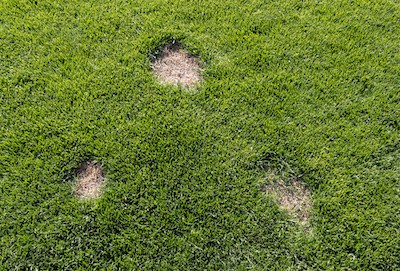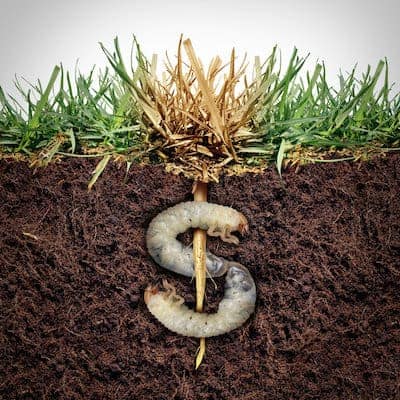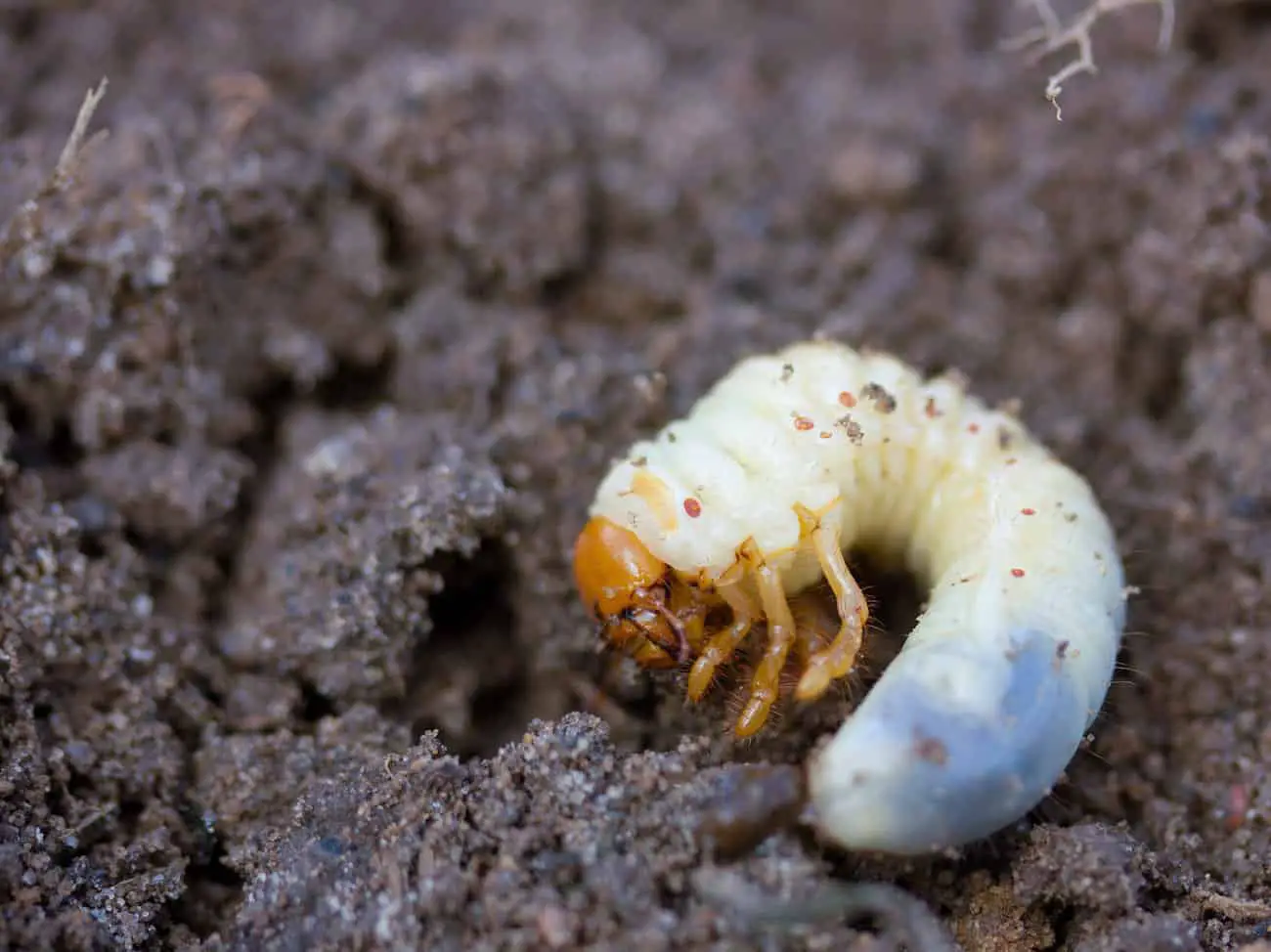How to Naturally Get Rid of Grubs
Have you been noticing lots of brown spots on your lawn recently and don’t know what’s causing them? There’s a good chance you’ve got some tiny little trespassers under the surface helping to destroy your beautiful summer grass. Grubs or grub worms are common in many lawns and if their population increases dramatically – they can cause some problems. Luckily for you, I’ve rounded up some natural ways to get rid of grubs and help your grass stay greener longer!
So, how do you get rid of grubs? If you’re worried about your family and pets encountering harsh chemicals from playing in the lawn after treating for grubs – don’t be! There are things you can do to decrease their population naturally.
- Introduce natural predators to the environment: birds and nematodes
- Spread milky spore mix on your lawn for a long-term solution
- Make the environment inhospitable – reduce watering
- Treat with neem oil – a botanical pesticide
Though some of these solutions may take longer than others to implement, each of them is successful and capable of letting you enjoy your yard again. Before we walk through each of these steps, let’s review what a grub is and the impact it can have on your lawn.
 What is a Grub?
What is a Grub?
Commonly referred to as “white grubs,” the little white worms you find in your lawn are the larvae of different Japanese and scarab beetle species. When they become adults, they are often called June Bugs or June Beetles.
Grubs are typically found in soil, decaying wood, and manure. Light in color – often appearing white, hence the nickname, and c-shaped, grub worms are rather small. Only growing to about 1/2 to 1 inch in length.
If you’re wondering why they turn your lawn brown, it’s because they feed on the roots of the grass. And, as was mentioned earlier, they are usually only a problem when their population is elevated. The Japanese beetles will lay their eggs midsummer in the more sunny areas of the lawn – so you won’t notice them until late summer/early fall.
Grubs like warmer temperatures and moisture, when it turns cold, they go into hiding – burrowing under the soil to stay warm and survive. The grubs found in your lawn have one-year life cycles, but can grow and reproduce quickly.
You may now be wondering “Do I have grubs? How do I find out?” Those are good questions! Unless you have several brown patches in your yard, you likely don’t have an infestation of grubs, so don’t worry about checking. However, if you do have a patchy lawn, you can check yourself to see what’s going on!
Go to one of the brown patches on your lawn and remove some of the sod from the middle of the patch – about 3 inches deep. Sift/rake through the soil underneath and look for small, white, c-shaped worms. If you’re seeing more than 5-8 grubs in that one area, you might want to start formulating a treatment plan.
How do you do that? Let’s find out!
Introduce Natural Predators to the Environment
Anytime you’re looking to naturally reduce the population of an insect or pest, introducing predators to the species is always a good place to start. It can be very effective, and also quite inexpensive. For white grubs, these predators are nematodes and birds.
Nematodes:
Nematodes, or roundworms, can be found online or at your nearest home and garden store. Once you introduce them to the affected areas, they will release bacteria into the soil, which will infect and kill the grubs – without also harming your lawn. They work quickly to kill off the population, but you may not see your grass healing until it begins regrowing.
Birds:
It’s no secret that birds like worms, in fact, it’s their main food source. So wouldn’t it make sense to entice them into eating the pesky grub worms under your lawn?
Some individuals have found success in placing bird houses in strategic areas of their lawn to attract birds. Once the birds visit the houses, they will begin to see and feed on the grubs in the grass. They get fed with a tasty treat, and you get to see your grass return to normal.
Though it’s not likely, it is possible that too many birds could affect your lawn in another way while feeding on the grubs. If your “attraction” works too well, the birds could damage the lawn by pulling up some of the grass and leaving it barren, so be cautious and regularly check the effectiveness of the trap.
Spread Milky Spore Mixture on Your Lawn – A Long-Term Solution
Milky spore disease is a naturally occurring pathogen that helps get rid of and prevent infestations of different lawn pests. It does take about one to three years to become fully effective, so while you use the mixture on your lawn now, you should also institute a short-term solution.
You can find milky spore mix online at different retailers and it’s very easy to use. Simply spread the mixture on the affected areas, and wait! The thing that’s so nice about using this mixture, is that it continuously releases spores once the grubs die and decompose – which effectively prevents future infestations for years to come.
This mixture does not harm your yard or garden, and it’s also an inexpensive way to treat your lawn.

Make the Environment Inhospitable – Reduce Watering
Another solution to getting rid of grubs in your yard naturally, is to make their environment uninviting and inhospitable. When we talked about the nature of white grubs, it was mentioned that they like warm temperatures and moisture.
If you’re able to get rid of the moisture, the eggs will die and infestations will not appear.
I’m definitely not recommending that you dry up your lawn; however, if you live in an area where drought occurs, you can help fix your problem during this time.
As the summer drags on and the temperatures soar, without rain in sight, my suggestion is that you continue to limit the number of times you water. This can help effectively dry out any of the population left and make it more difficult for it to come back when water is reintroduced.
If you choose to attempt this way of reducing the population of grubs, be careful that you aren’t killing the rest of your lawn. You should closely watch the weather and feel the ground to determine the level of dryness your grass is experiencing.
Treat with Neem Oil – A Botanical Pesticide
Neem oil is known as a botanical pesticide. It works as a natural repellant that deters beetles from laying eggs, growing, and keeps grubs from feeding. All you have to do is mix it with water, as directed, and spray it onto the affected areas of your lawn.
You can find neem oil online or at your nearest home and garden store and an expert there can help you determine how much you need. Although, it might be good to keep some on-hand for any future problems that could come up. It is an inexpensive option both in time and money.
Non-Natural Option – Chemical Control
Unfortunately, the natural way does not always work. If this is the case for you, you can still treat your lawn with safe chemicals and not have to worry about the problem any longer. Whether you choose to do your own research or consult with a lawn and garden professional, there are many chemical treatments you can find that won’t be harmful to your family or pets.
Some organic fertilizers only need to be used twice a year! Or you can work with a lawn care company to spray/treat your yard at regular intervals – monthly, seasonal, etc. The reality is, you don’t need to be scared of using chemicals to treat the issues you’re having. If the problem is out of control, sometimes it’s just the best way to fix it.
Enjoy Your Lawn Again
Not everyone takes pride in their lawn, and not everyone wants to take time to fix pest issues. However, I will say that a nice, full, green lawn is always more beautiful and enjoyable. Each of these treatment options we talked about is inexpensive, works relatively quickly, and is easy to implement.
Get back to enjoying a game of kickball with no shoes, or having picnics in the evenings on your soft, grub-free lawn again!
 Related Questions
Related Questions
When should I treat for grubs?
The best time to treat for grubs is when they are active and feeding – which would be both in the spring and the fall. In the spring, the grass is starting to grown again and the nutrients in the roots are flowing. As the life cycle continues, they cocoon and become adult beetles at the start of summer.
Adult beetles will then lay their eggs mid-to-late summer, and the larvae will begin feeding again as the season changes to fall. Over the winter, the larvae will burrow deep into the soil to avoid the freezing temperatures. And thus, the life cycle continues.
Can non-treatment of grubs lead to more lawn problems?
Chances are you won’t even notice that you have a grub infestation, and so you won’t treat for them. Brown spots and patches on the lawn can be caused by a number of different things, so it’s possible that grubs are not the root of your problems.
If you’ve checked and they do seem to be the problem, then it would be a good idea to treat them. There wouldn’t be any “serious” problems that arise from not treating, but you could experience continued patches on your lawn, and they could attract other predators that could destroy your grass.
The truth is, if the patches don’t bother you or they are in places you’re not worried about, then it’s up to you whether to treat them or not! I will say, however, it’s always good to treat for any infestation or increase in pest population before it grows bigger. Not to mention, full, green grass is always nice to look at.
Where are grubs most likely to be found?
There are many different kinds of grubs, but unfortunately, they can be found pretty much anywhere. Depending on the type of beetle, grubs can be deadly to crops such as corn, or just pesky causing brown spots on lawns near the end of summer.
It is true that grubs do not like and do not survive in freezing temperatures, however, chances are you will encounter grubs at some point in the summer season.

